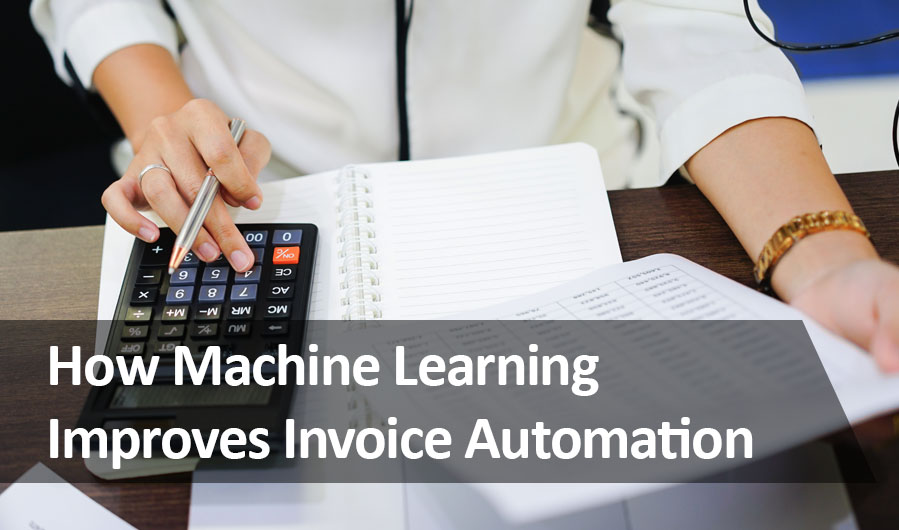How Machine Learning Improves Invoice Automation
In every industry, accounts payable (AP) and related invoice management teams are beginning to recognize the benefits of incorporating automated workflows with embedded machine learning capability. These tools help finance departments reduce errors, identify fraud, and save substantial money. For example, a 2020 U.K. survey shows that accounts payable automation software can save a business $16 or more per invoice. What is curious is that accounting and AP departments have been slow to implement this valuable software. In fact, only 21 percent of accountants have invested in automation software as of 2020.
A common concern and roadblock to adopting new invoice technologies revolves around the amount and variety of information encountered. For example, AP systems must process invoices in multiple formats (email, EDI, PDF, spreadsheet, fax, etc), additional details sent in secondary emails, then cross check information with goods received, multi-point review and approval workflows, and more. In addition, as technology advances an increasing number of systems must be integrated to manage and monitor the full process.
Many early automation solutions were not able to consistently capture and process the wide range of document and data layouts and detail, and required additional manual review or tedious system training. This reduced the effectiveness and ROI of the solution. Fortunately, the machine learning capability in best-in-class solutions has greatly improved, automatically improving its accuracy. These solutions are becoming essential for competitive businesses to quickly adapt to ever-evolving information sources and accurately execute user-defined workflow rules.
An example of a solution that leverages the power of machine learning well is SAP Invoice Management by OpenText (VIM). As a best-in-class solution it uses advanced machine learning to streamline the ingestion and management process and minimize issues that need to be resolved by hand. The end result is reduced manual data entry and team members reclaiming valuable time needed to focus on knowledge-based tasks that provide more benefit to the department.
What Is Machine Learning?
While there is an ongoing debate about the specific details of what machine learning encompasses, according to IBM “machine learning is a branch of artificial intelligence (AI) and computer science which focuses on the use of data and algorithms to imitate the way that humans learn, gradually improving the accuracy of the process.” The improvement is an essential point. The system ‘gets smarter’ as its data set increases without any additional programming required.
A common use of machine learning software is in the initial data capture, aggregation and organization step required in almost every data-powered process. An input system (i.e. a scanning or OCR solution) is tasked with ingesting and organizing a set of data contained in documents and files, and delivers it to a connected system for additional work. As the input system experiences a wider variety of document or file scenarios, it continually increases its accuracy, ‘learning’ where information is located, how to read it correctly, and where it should be placed within the data structure. Occasional guidance and ‘coaching’ by human operators helps overcome occasional issues that the software cannot resolve alone. It quickly becomes rare for the system to encounter a file, format, or situation that it cannot process accurately.
Machine Learning Improves Invoice Automation for SAP Invoice Management
Over the last few years it has become more common for invoice management tools to include some level of machine learning capability in their system. While this has improved their capability, one of the challenges they have faced is the extensive data set that is required to establish an accurate set of base functionality. It sometimes takes several months of system ‘training and education’ to get a machine learning solution up to speed in a department.
Fortunately that is not always the case. Powerful machine learning is a core advantage of the SAP Invoice Management by OpenText (VIM) solutions, but what sets it apart from its competitors is the solution is built on an extensive core of invoice and document format data sourced from SAP’s thousands of worldwide businesses. Out-of-the-box the solution easily recognizes and captures an extremely high percentage of invoices in a vast array of files and formats including email and PDF attachments, EDI, and more. It can also decode and organize data from sources never encountered by the system before, as well as detect duplicate invoices, verify vendor details, and catch many issues that cause errors further along the invoice pipeline. In addition, if vendors, suppliers, or partners have a few unique document data or format challenges, documents that have incomplete or questionable data are flagged for human review. When resolved, the system’s advanced algorithms ‘remember’ the solution and continually improve capture accuracy.
This automated and continual improvement brings an important advantage. An efficient, always improving ingestion flow eliminates one of the most time-consuming, resource heavy, and costly aspect of an AP team-data input and verification. Most companies are able to go from manual data entry to 100 percent automated capture in a few weeks and often save more than 80-90% of per-invoice processing costs.
With an efficient input workflow, it becomes much easier to develop a clear set of rules that organize the data and route each document to the next appropriate step in a workflow chain. The system can then automate additional steps, route tasks to the required team members, and continually provide relevant data and documents for analysis and decision making, all with clear reporting and insights of system, staff, process and partner efficiency.
Final Thoughts
SAP Invoice Management by OpenText (VIM) provides businesses with a powerful solution to manage a complex range of information and tasks in departments like AP, AR, sales, and beyond. With powerful trained machine learning, the application reduces the amount of time spent on mundane manual tasks and significantly reduces errors and possible fraud. In addition, it gives companies more control over their financial processes, boosts productivity, and empowers employees to shift their focus to more value-generating work. It’s also important to note that this functionality is available for both on-premise and cloud environments, whether deployed with a hyperscaler partner or on SAP’s S/4HANA platform.
Learn more about how to increase the efficiency of your AP, procurement, and invoice management workflows here, or contact us to schedule a time to meet with one of our experts to discuss what solutions are available to address your unique challenges.





